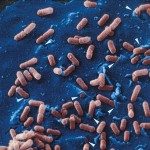Lien vers Pubmed [PMID] – 8748026
Mol. Microbiol. 1995 Nov;18(3):413-23
Listeria monocytogenes and Shigella flexneri are two unrelated facultative intracellular pathogens which spread from cell to cell by using a similar mode of intracellular movement based on continuous actin assembly at one pole of the bacterium. This process requires the asymmetrical expression of the ActA surface protein in L. monocytogenes and the IcsA (VirG) surface protein in S. flexneri. ActA and IcsA share no sequence homology. To assess the role of the two proteins in the generation of actin-based movement, we expressed them in the genetic context of two non-actin polymerizing, non-pathogenic bacterial species, Listeria innocua and Escherichia coli. In the absence of any additional bacterial pathogenicity determinants, both proteins induced actin assembly and propulsion of the bacteria in cytoplasmic extracts from Xenopus eggs, as visualized by the formation of characteristic actin comet tails. E. coli expressing IcsA moved about two times faster than Listeria and displayed longer actin tails. However, actin dynamics (actin filament distribution and filament half-lives) were similar in IcsA- and ActA-induced actin tails suggesting that by using unrelated surface molecules, L. monocytogenes and S. flexneri move intracellularly by interacting with the same host cytoskeleton components or by interfering with the same host cell signal transduction pathway.

